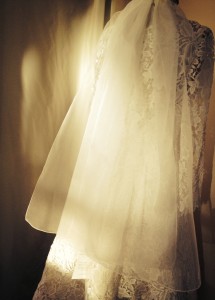A wedding dress is not complete without a veil.ô But whatô is its significance?
Nowadays the veil serves a purely aesthetic function and gives the final touch to the bridal look.
Howeverô the veil has a long tradition which grounds its roots in ancient times.
The first veil goesô back to the Roman times when the young brides ascending to the altar wore theô Flammeum, a lightô redô veilô whichô covered the face during the nuptial ceremony.ô During ancient Roman timesô weddings were often arranged by the familiesô and theô spouses could not meet each other. The veil worn at the altar served to hide the bride’s featuresô until the very last moment,ô when basicallyô it was too late for the groom to run away.
Arranged marriages and hiding the bride under a veil until the end of the ceremonyô was still being practiced duringô Medievalô times.ô Made of linen layers,ô the veilô was also intended to protect the brideô from evil spirits who might wish to thwart her happiness.
During theô Renaissanceô the ceremony became a social moment to show off and the look of the veil also changed. Itô was made from fine fabrics, longer than the bridal dress and considered a proper accessory for the occasion.
The current tradition finds its origin in Romanticism: theô long white dress was recognized by the Catholic Church as representing purity and virginity, along with the white veil, the gloves, the nuptial cake and the reception.
Only fromô the 20thô centuryô do weô see proper bridal trends in line with historical andô economicalô times, new designers and personal preferences. Inô factô we can see distinctively different looks throughout the decades.
In theô Twentiesô the veil had a long train decorated with gems and embroideries.
In theô Thirtiesô the veil became short, enriched with tiaras and beads.
From the Fiftiesô the veil becomes very elegant, long with different cuts and details which complement the look of the dress.
I want to conclude this brief excursus about the veil with a quote from an American fashion writer, Mary Brooks Pickens (1886-1981) ã Veils, like perfume, are an exquisite luxury if they are dainty, delicate and becomingã


